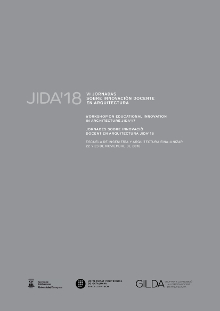The touristic territory, an approach from teaching innovation in Architecture
DOI:
https://doi.org/10.5821/jida.2018.5531Abstract
Mass tourism, of sun and beach, continues being one of the most active sectors in both urban and regional scales. However, despite its importance, it has not been properly integrated as a study field in the training education of future architects. The School of Architecture of the University of Malaga (Spain), since its foundation, identified this lack and included the tourism as a subject in its Study Programme. The objective was to create an approach to the touristic territory from architecture and landscape. This decision has represented an exercise of teaching innovation and its experiences are the central part of this paper.
References
ALEDO, A., MANZÓN, T., MANTECÓN, A. (2007). “La insostenibilidad del turismo residencial.†En Lagunas, D. (coord.) AntropologÃa y turismo. Claves culturales y disciplinares. México: Plaza y Valdés.
BARBA, R. y PIE, R. (1996). Arquitectura y Turismo: planes y proyectos. Conferencias y materiales del Programa de Postgrado Arquitectura y turismo. Barcelona: Centre de Recerca i Projectes de Paisatge (CRPP).
BARROWS, H. (1986). “A Taxonomy of problemâ€based learning methods†en Medical Education, vol. 20, p. 481â€486.
BOWDEN, J. y MARTON, F. (2012). La Universidad. Un espacio para el aprendizaje. Más allá de la calidad y la competencia. Madrid: Narcea.
BUNSCHOTEN, R. (2001). Urban Flotsam. Rotterdam: 010 Publishers.
BUNSCHOTEN, R. (2004). “Urban Gallery, Urban Curation†Schrenk, M. (coord.) En: 9th International Symposium on Planning & IT (22 - 24 February. 2004. Viena). Disponible en: < https://www.corp.at/archive/CORP2004_BUNSCHOTEN.pdf> [Consulta: 14 de mayo de 2018].
COROMINES, E. y SOLA, P. (1990). Debat urbanÃstic sobre la Costa Brava. Girona: Col·legi d’Arquitectes de Catalunya, Demarcació de Girona.
DEBORG, G. (2010). “TeorÃa de la deriva†en Revista Anthropos. Nº 229, p. 197.
ESCUELA TÉCNICA SUPERIOR DE ARQUITECTURA DE MÃLAGA. (2015). Programación docente del curso 2015. <https://oas.sci.uma.es:8443/ht/2015_2016/> [Consulta: 11 de Noviembre 2015] [Sin autorÃa reconocida]
GALACHO JIMÉNEZ, F. B. y LUQUE GIL, A. (2000). “La dinámica del paisaje de la Costa del Sol desde la aparición del turismoâ€. Baética. Estudios de Arte, GeografÃa e Historia, Facultad de FilosofÃa y Letras Universidad de Málaga, Nº22, p. 25-58.
IECA (Instituto de EstadÃstica y CartografÃa de AndalucÃa, Junta de AndalucÃa). (2013). “El tiempo vuela… Torremolinos 1962-2010†en EstadÃstica y CartografÃa de AndalucÃa, 25 de septiembre. <http://www.juntadeandalucia.es/institutodeestadisticaycartografia/blog/2013/09/el-tiempo-vuela-torremolinos-1962-2010/> [Consulta: 26 febrero 2017].
IMBERNÓN, F., (1995). La programación de las tareas en el aula: un proceso contextual, dinámico y flexible. Buenos Aires: Magisterio del RÃo de la Plata.
MAKI, F., (1964). Investigations in Collective Form. St Louis: Washington University Press.
PIE, R. (2014). “Las arquitecturas del turismo: las piezas mÃnimasâ€. En Pie, R. y Rosa, C. J. (ed.) Turismo LÃquido. Barcelona: Iniciativa Digital Politécnica-UPC.
VENTURI, R. y BROWN, D. S., (2011). Aprendiendo de las Vegas. Barcelona: Gustavo Gili.



















